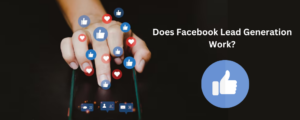The ultimate goal of marketing is to secure a multitude of high-quality leads for your business, and one of the most well-known and effective methods for achieving this is through advertising. Indeed, advertising plays an important and distinct role in the toolkit of any modern marketer, making it an essential ingredient for success.
Generating leads is the ultimate objective of any marketing strategy adopted by a company. Leads refer to potential customers who may be interested in purchasing the company’s products or services. The process of identifying and establishing communication with such individuals is known as lead generation.
Lead generation can take various forms and can be categorized into two main types: inbound and outbound marketing. Inbound marketing involves creating specialized content to appeal to your ideal customer and draw them to your brand. On the other hand, outbound marketing is focused on capturing the attention of potential customers who may not have prior knowledge of your product or brand.
Advertising is an essential marketing tool that falls under the rapidly evolving discipline of outbound marketing. It plays a critical role in reaching out to potential customers who may not be familiar with a brand. In this context, we will examine how advertisements fit into the broader marketing landscape and explore their similarities with inbound marketing.
Outbound Marketing in the Digital Age
If you’re looking for effective ways to generate more leads, outbound marketing tools are worth considering. These marketing methods utilize accessible public platforms that can be accessed at a lower cost. While traditional outbound marketing tactics included radio, TV, and print media, the focus has now shifted to digital channels such as blogs, email campaigns, and social media.
Blogs, for instance, allow businesses to create SEO-optimized content that appeals to their target audience, while email campaigns provide a cost-effective way to reach out to customers with personalized messages. Social media, on the other hand, enables businesses to build a loyal following and engage with customers in real-time. The pillars of modern outbound marketing are cost-effective digital channels that offer a high potential return on investment for businesses of all sizes.
How to Rank High on SERPs and Drive Organic Traffic?
Outbound marketing strategies encompass a wide range of techniques that can help businesses generate leads and boost their customer base. One of the most important tactics is creating search-engine optimized (SEO) content that ranks high on search engine results pages (SERPs) and drives organic traffic to a company’s website. This can be achieved by incorporating relevant keywords and phrases that align with the search queries of the target audience.
While SEO content is important for driving traffic to your website, don’t overlook the power of relevant blogs, vlogs, and video testimonials. These types of content not only engage your audience but also provide them with valuable information, building trust and loyalty over time. By using a mix of outbound marketing tactics, you can increase brand awareness and position your business as a thought leader in your industry.
Advertising campaigns are another key component of outbound marketing. By utilizing paid advertising channels such as social media ads, Google Ads, or display ads, businesses can effectively amplify their brand visibility and reach new customers. This approach also allows companies to target specific audiences with personalized messages that resonate with their interests and needs.
The Role of PPC Advertising in Modern Digital Marketing
The most valuable leads for any business are those who have a genuine interest in their product or service and are motivated to spend money on it. In the online world, advertising offers a range of useful tools for identifying and targeting these potential customers.
One of the most popular and effective ways to generate leads through online advertising is by using pay-per-click (PPC) ads on social media platforms like Facebook or search engines like Google. With this approach, businesses only pay for each click that leads customers to a landing page on their website, rather than for the ad itself. This provides a cost-effective way to attract potential customers who are actively searching for products or services like those offered by the business.
Once a customer clicks through to the landing page, businesses can gather valuable data on the customer and their interests. This information can then be shared with the sales team, who can use it to reach out to potential customers and convert them into active business. This approach not only helps to increase the chances of closing a sale but also provides insights into the target audience’s preferences and behavior, enabling businesses to optimize their marketing strategies in the future.
The Importance of Considering Components Before Launching a PPC Campaign
While PPC campaigns may be cost-effective, it’s important to consider the various components involved before launching one as they can be complex and require careful consideration.
- To run a successful PPC campaign, your website must be compatible with the platform you are linking to. This means ensuring that your website’s design, functionality, and content align with the requirements of the PPC platform. Failure to do so can result in a subpar user experience, which can negatively impact your conversion rates and ROI.
- Besides being compatible with the PPC platform, your website should also be optimized for speed to increase the chances of converting click-throughs into sales. Slow loading times can cause users to leave your site without engaging with your content, resulting in lost opportunities for conversions. To avoid this, it’s important to optimize your website’s speed by reducing the size of images, minimizing code, and avoiding unnecessary plugins.
- While PPC campaigns can be cost-effective, they do come with certain costs that businesses need to budget for. These costs include expenses related to art, design, copywriting, and editing for the ad itself, landing page creation, thank-you messages, and automated responses. It’s essential to factor in these costs when planning your PPC budget to ensure that you can create high-quality campaigns that resonate with your target audience.
- To maximize the effectiveness of your PPC campaign, it’s important to choose the right platform based on your product or service, target audience, and market research. This requires thorough planning and ongoing optimization to ensure that you are targeting the right audience with the right message at the right time.
- PPC campaigns generate leads that need to be followed up by a sales team to turn them into paying customers. Allocating resources for lead nurturing is critical to the success of your PPC campaign. This involves creating a robust lead management process that includes tracking, scoring, and prioritizing leads based on their level of engagement and interest in your brand. By doing so, you can increase your chances of converting leads into actual customers and driving revenue growth for your business.
Pay-Per-Lead Ads: An Overview
Pay-per-lead ads are a form of advertising that can be purchased through ad agencies. With this service, the agency manages all aspects of the ad campaign, including lead generation and the first follow-up with interested leads. In some cases, the agency may even take on the initial contact with potential leads, freeing up your time and resources to focus on other business tasks. This allows you to maximize your return on investment while minimizing the time and effort required to manage your advertising campaigns.
Pay-per-lead (PPL) ads are an attractive option for small businesses looking to advertise online without having to handle the complexities of digital marketing technology. Creating and managing PPC campaigns in-house can be time-consuming and stressful. By using a PPL service from an agency, your business can benefit from their expertise and knowledge. The agency can also create a customized sales funnel that does not necessarily require a link to your website, providing even more convenience for your business.
Pay-per-lead (PPL) campaigns rely on ads as their core component and can initially cost more than pay-per-click (PPC) campaigns. Working with the right agency, PPL campaigns can ultimately save your business money. When comparing the costs of PPL and PPC, it’s important to keep in mind that PPL costs extend beyond just the ad creation process. The value of each lead can also impact the overall cost per lead, with more detailed and richer data resulting in a higher price per lead.
To successfully utilize PPL campaigns, it’s important to have trust in the agency you choose. This requires conducting thorough research before committing to any particular agency.
Value of Traditional Advertising for Local Brand-Building
Traditional advertising methods through mass media such as newspapers, television, and radio have been declining in popularity over the last decade due to the rise of digital ads. This shift is mainly due to the significant advantages that the digital space offers, including:
- Cost-effectiveness: Digital ads are generally less expensive than traditional ads.
- Boundless reach: The internet provides a global audience, making it easier to reach people worldwide.
- Measurable results: It’s easier to track and measure the results of digital ads, providing businesses with valuable insights.
- Targeted advertising: Digital advertising allows for targeting specific audiences based on demographics, location, interests, and other factors.
- Interactive and appealing ads: Creating interactive and visually appealing ads is easier in the digital space, which can increase engagement and conversion rates.
As a result of its numerous advantages, the internet has experienced a significant increase in its share of advertising spending over the past decade. While TV advertising has remained a close competitor, most other traditional advertising media have experienced a decline. This trend can be attributed to the fact that today’s youth is more accustomed to engaging with online content and less inclined to pay attention to conventional ads.
Despite the shift towards digital advertising, traditional ads still hold value in local brand-building, particularly for contractors. Print ads, for instance, can have a lasting impact on brand recall that digital media may not achieve. Similarly, local television and radio ads still have the potential to reach engaged audiences, who are more likely to seek out a contractor in their community than someone found through casual online searches.
As the world becomes increasingly digital, traditional advertising platforms are adapting to the changing landscape. Television broadcasters are rapidly transitioning to the online streaming space, and it’s clear that the digital economy will continue to dominate the ad space in the future. However, this doesn’t mean that traditional ads should be dismissed entirely. They still have a place in the advertising world and can be an effective way to reach certain audiences.
Inbound Marketing for Small Businesses and Contractors
The driving force behind inbound marketing is content, which aims to establish recognition and trust with potential customers who discover your brand. Unlike advertising, which simply puts your brand out there to attract new customers, inbound marketing targets individuals who are already interested in your content. Nowadays, customers are well-informed and selective about which brands they choose to do business with, and simply providing information about your product is no longer enough to convince them to buy from you.
Inbound marketing relies heavily on content, which can take many forms, such as e-books, white papers, webinars, and infographics. These types of content are commonly used to establish credibility and trust with potential customers, who may not be ready to buy immediately. For small businesses and contractors, tools like blogs, videos, and customer spotlights can also be effective in generating leads without resorting to pushy sales tactics. By providing valuable information and resources to potential customers, inbound marketing can attract and retain a loyal audience, ultimately leading to increased sales and business growth.
The Importance of Blogs, Videos, and Customer Spotlights in Marketing
Inbound marketing becomes most effective when it provides leads with a personal context and connection to your business and its offerings. This is where blogs can be an excellent starting point. By creating informative and engaging blog content, businesses can establish a relationship with potential customers, which can lead to increased trust and loyalty. Blogging can also help to establish a brand’s voice and personality, making it easier to connect with customers on a personal level. Ultimately, these connections can lead to increased sales and business growth.
Blogging has proven to be a cost-effective way of promoting a business, especially for contractors looking to demonstrate their extensive knowledge and problem-solving skills. Through blog posts, contractors can share their passion for their work and the values they hold dear, as well as highlight specific projects to showcase their expertise to potential clients. This makes blogging a valuable tool for showcasing the unique strengths that contractors bring to the table.
Video marketing is an incredibly effective way for contractors to showcase their skills and give potential clients a glimpse into their process. Whether it’s through a blog or a social media campaign, video content on platforms like YouTube, Facebook, and TikTok has the power to captivate audiences and leave a lasting impression. By demonstrating their expertise and attention to detail, contractors can build trust with viewers and turn them into loyal customers.
Highlighting satisfied customers through customer spotlights or case studies can help contractors win over potential clients who may be unsure about their services. By showcasing real-world examples of customers who have benefited from their work, contractors can demonstrate their capabilities and build trust with potential clients. Customer spotlights provide an authentic look at the positive experiences of others, which can ultimately lead to increased sales and business growth.
How Inbound Marketing and Advertising Share Similarities
Advertising and inbound content-based marketing share several similarities.
- Content-driven marketing is a complex undertaking with many moving parts that require a significant investment of time and resources. It’s akin to running your own ad campaigns, requiring extensive planning and scheduling for content creation, as well as expenses for design, copywriting, and copyediting. The cost can vary depending on the level of video or photography content you want to use, making it a challenging proposition for small businesses with limited personnel.
- The more valuable the leads you generate through inbound marketing, the higher the cost may be. While inbound marketing can be a highly effective way to engage with visitors to your website and social media channels, maximizing those connections often requires a greater upfront investment. It’s important to note that there is no guarantee that the resulting leads will be profitable enough to offset the costs. To make inbound marketing a cost-efficient strategy, it requires careful research and strategic planning.
- Similar to outbound advertising, inbound marketing can also be outsourced to specialized marketing agencies. These agencies have the expertise to develop effective inbound marketing strategies and campaigns, taking care of tasks such as content creation, SEO, and complex social media strategies. Partnering with the right agency can alleviate the burden of generating inbound leads, but it’s important to consider the cost and conduct thorough research before selecting an agency to work with.
In general, inbound marketing and advertising share a commonality in that they are not easy to handle in-house and are often better outsourced to specialized contractors. When executed correctly and with sufficient resources, both can be effective methods for generating leads.
Conclusion
Lead generation and advertising are two important components of any successful marketing strategy, and they can work together to produce even greater results. Advertising can help increase brand awareness and drive traffic to a business’s website, while lead generation tactics can then be used to convert that traffic into qualified leads. By utilizing both approaches in a complementary manner, businesses can maximize their marketing efforts and achieve their goals more efficiently. Ultimately, a well-rounded marketing plan that combines lead generation and advertising can help businesses establish their brand, expand their reach, and drive growth over the long term.




